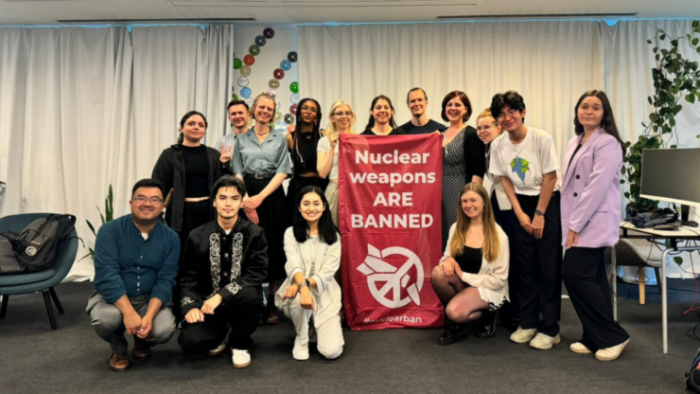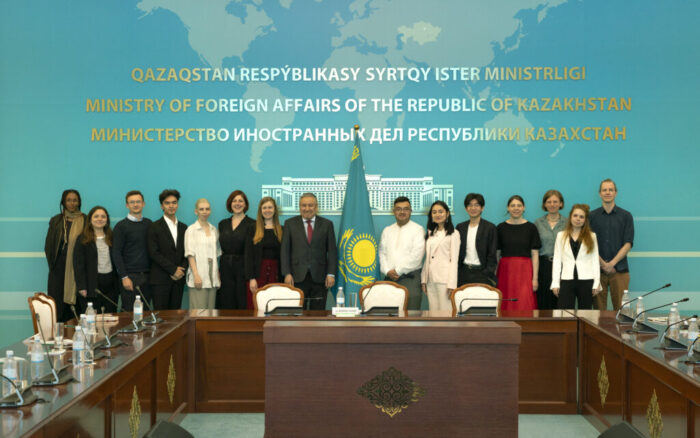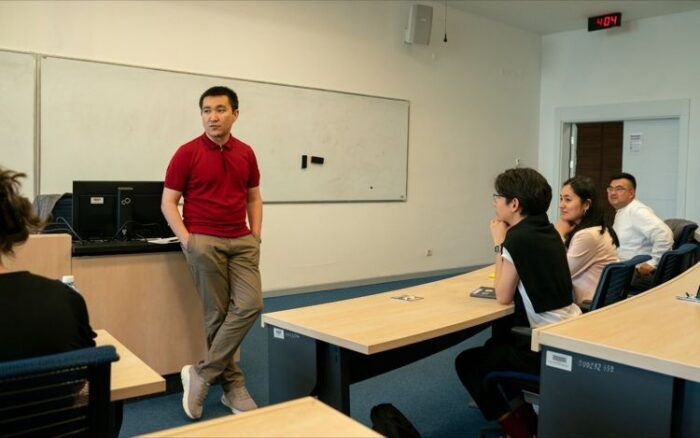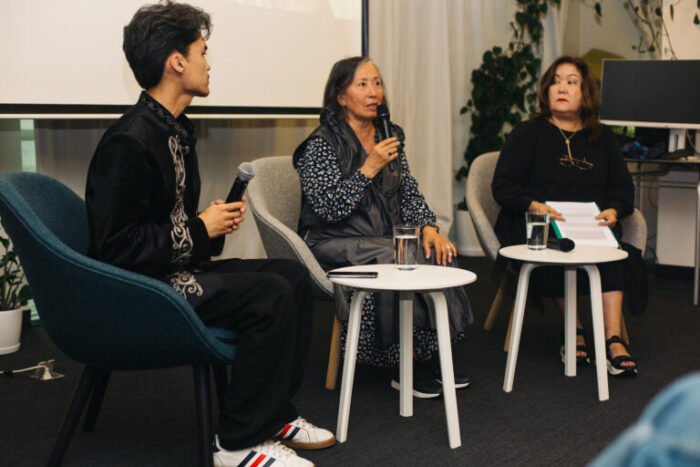ASTANA—A group of 20 young changemakers from Kazakhstan and Germany recently embarked on a week-long educational journey through Kazakhstan to explore the country’s nuclear past, meet policymakers, and talk to affected communities.

Members of the group. Photo credit: icanw.de
The tour took the group to the ministerial halls in Astana, activists in Almaty, researchers, and the nuclear-affected communities in Semei, which was once the site for the Soviet-run nuclear test site. This educational tour, organized by the Friedrich Ebert Foundation in Kazakhstan, ICAN Germany, and Kazakhstan’s STOP (Steppe Organization for Peace) youth initiative, aimed to foster a deeper understanding of nuclear non-proliferation and amplify the voices of affected communities.
Kazakhstan’s Semipalatinsk nuclear test site was a venue for the Soviet Union to test nuclear weapons. Official data indicates that 456 nuclear tests between 1949 and 1989, including 340 underground and 116 atmospheric tests, were conducted at the test site, with an area of 18,300 square kilometers.
Around 1.5 million people have been affected by radiation exposure over the years, including health consequences such as an increase in cancer rates, birth defects, and other radiation-related illnesses among the local population. The long-term effects are still present for generations.
Meeting with government officials in Astana
Astana was the first stop on the trip. The group visited the Kazakh Ministry of Foreign Affairs. There, Arman Baissuanov, the head of the ministry’s international security department, briefed them on the country’s nuclear history and its leading role in global non-proliferation efforts. He also discussed Kazakhstan’s role in the Central Asian Nuclear Weapon Free Zone and the Treaty on the Prohibition of Nuclear Weapons (TPNW).

The group at the Ministry of Foreign Affairs of Kazakhstan in Astana. Photo credit: Bennet Rietdorf
Among other officials, the group met with Roman Podoprigora, a judge of the Constitutional Court of Kazakhstan, who spoke about recommended changes to the 1992 law on those affected by the nuclear tests, and Nurlan Auesbaev, a member of the Parliament.
Yerdaulet Rakhmatulla, co-organizer of the study tour, described it as a positive sign that civil society representatives could visit the ministry and productively discuss the nuclear politics and more. According to him, it is quite a rare occasion.
“I think just this step from their side was a great sign of progress in our bilateral relationships as state, as government and civil society,” he said in a comment for this story.
Officially titled the law on social protection of citizens who suffered from nuclear tests at the Semipalatinsk nuclear test site, the document envisioned measures to address the severe health and social impacts. However, experts say the law has many shortcomings, including a limited scope of financial compensation, which is insufficient to cover the long-term health needs of the affected population. The law’s criteria to identify affected individuals have also been seen as too narrow.
When meeting with policymakers, Rakhmatulla mentioned there were discussions about integrating or substituting the Kazakh compensation system with the United States model. However, he stressed the American model should not be the one to aspire to.
“The U.S. system is not perfect. It is even worse than the Kazakh one. I think that was a sign for me that we should, beyond our activism and advocacy work in the field of policy, also connect with other groups,” he added.
Сonfronting the human impact of nuclear testing
Understanding Kazakhstan’s tragic nuclear past would not be complete without visiting the region where thousands of people witnessed the tests firsthand and have borne the consequences for many years since. In Semei, the young people met with people still grappling with the legacy of the Soviet-era tests, listening to their stories that, for some reason, often remain unheard.
Maira Abenova, a survivor of the Soviet nuclear tests in Semei and founder of the Polygon 21, an institution that advocates for the rights of Semipalatinsk nuclear test survivors, helped the group to meet those affected in Semei and Astana.

Meeting with activists and affected communities in Semei. Photo credit: Bennet Rietdorf
During the meeting in Semei, many of the survivors reported on their health problems, such as cancer and heart disease, according to a press report from ICAN Germany. They said they hope their voices will be heard internationally. Their voices “do not yet reach as far as those of Hiroshima and Nagasaki,” say the survivors.
For Rakhmatulla, these meetings were “extremely special.”
“After our trip, I think my personal perspective on nuclear proliferation and disarmament will transform immensely. I believe we should now stick to a more hawkish approach than before and especially build solidarity between the generations. Intergenerational dialogue and cooperation are key now,” said Rakhmatulla.
He emphasized the need for capacity building of regional activists and nuclear-affected communities, as they have the potential to make significant contributions but lack resources, knowledge, and networks.

The group also had a chance to meet with affected communities. Photo credit: Bennet Rietdorf
While in Semei, the tour members met with the Abai Region administration. They reported that the health consequences of nuclear tests remain a major problem.
Another problem is the lack of access to archives in Moscow, which makes claims for compensation difficult. The meeting also discussed the 1992 law on social protection of those affected, with them seeing many shortcomings in the law.
Talking to researchers
The participants of the tour also had a chance to talk to Kazakh researchers. In Astana, they met with Zhanibek Aryn from Nazarbayev University, who discussed Kazakhstan’s foreign policy and security.

Dr. Zhanibek Arynov gives a lecture to the group during their visit to Nazarbayev University in Astana. Photo credit: Bennet Rietdorf
They learned more about the research conducted at Semei Medical University, Alikhan Bokeikhan University, and Shakarim University.
Visit to Almaty
The trip to Almaty featured discussions with Kazakh activists and experts. One of the discussion topics was the Kazakh media landscape and how affected communities are represented. One key takeaway was that they are hardly represented in the media narrative.

Researchers whom the group met discussed the Abai Region’s socio-economic development and radiation assessments, among other topics. Photo credit: icanw.de
Another event in Almaty hosted the screening of the documentary “I Want To Live On: The Untold Stories of the Polygon.” The film, made by the Center for International Security and Policy (CISP) with the support of Soka Gakkai International (SGI), featured powerful testimonies of survivors and displayed the long-lasting impact of nuclear tests.
The screening was followed by a few panels featuring some of the prominent Kazakh experts on nuclear non-proliferation, including Togzhan Kassenova, an expert on nuclear politics and author of “Atomic Steppe: How Kazakhstan Gave Up the Bomb,” and Alimzhan Akhmetov, director of the Center for International Security and Policy.
Lessons learned
Janina Ruther, a participant of the tour and project manager at ICAN Germany, spoke to The Astana Times, sharing her impressions and key takeaways from the educational tour.
Ruther said the idea to organize such a tour came up last year. “Last summer, I met Aigerim Seitenova [a nuclear non-proliferation activist from Kazakhstan]. We talked a lot, and I was very much interested in the stories that she told me,” she said, noting that the idea of organizing an educational tour in Kazakhstan resonated with her.

At a panel session in Almaty. From L to R: Yerdaulet Rakhmatulla, Gulsum Kakimzhanova, a veteran of the Nevada-Semei Anti-Nuclear Movement, and Kaisha Atakhanova, a Kazakh biologist and social activist. Photo credit: icanw.de
“In November-December last year, I met the team of STOP at the UN conference, the second meeting of state parties [to TPNW] in New York. Aigerim introduced us, and then we talked a bit about the whole idea, and together, we decided, we can make it happen,” said Ruther.
Studying intercultural communication and conflict studies in Germany, Ruther acknowledged she didn’t focus much on nuclear weapons or their abolition during her studies, but it was not until two years ago when she came across a youth delegation to a conference in Vienna.
Because of her experience with ICAN, she got to know more about Kazakhstan and the country’s history with nuclear weapons.
Ruther said what made the trip so special was the variety of places they visited and the diverse range of people they spoke to in different contexts.
“That was so special, and it made it a once-in-a-lifetime experience,” she added. “I think I don’t have words for that because we talked to so many people who were actually surviving all these tests. It was so brave that they talked to us because I cannot imagine how hard it must be.”
She also shared meeting young people at the universities and experiencing the night train journey was unforgettable.
“Something that I will not forget, because the manager of the train was also affected by nuclear weapons herself. She was from Semei. It was very interesting to know. We started talking because she asked what we were doing there,” she said.
She described the tour using a quote from one of the meetings: “The more we educate young people, the greater the hope for a world without nuclear weapons.”
She stressed that the primary goal was to reach young people who could spread the message and educate others. Equally important was understanding the needs and desires of the people affected by nuclear testing in Kazakhstan and bringing their voices to an international level.


